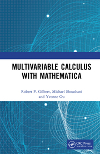- About MAA
- Membership
- MAA Publications
- Periodicals
- Blogs
- MAA Book Series
- MAA Press (an imprint of the AMS)
- MAA Notes
- MAA Reviews
- Mathematical Communication
- Information for Libraries
- Author Resources
- Advertise with MAA
- Meetings
- Competitions
- Programs
- Communities
- MAA Sections
- SIGMAA
- MAA Connect
- Students
- MAA Awards
- Awards Booklets
- Writing Awards
- Teaching Awards
- Service Awards
- Research Awards
- Lecture Awards
- Putnam Competition Individual and Team Winners
- D. E. Shaw Group AMC 8 Awards & Certificates
- Maryam Mirzakhani AMC 10 A Awards & Certificates
- Two Sigma AMC 10 B Awards & Certificates
- Jane Street AMC 12 A Awards & Certificates
- Akamai AMC 12 B Awards & Certificates
- High School Teachers
- News
You are here
Multivariable Calculus with Mathematica

Publisher:
Chapman and Hall/CRC
Publication Date:
2020
Number of Pages:
428
Format:
Hardcover
Price:
99.95
ISBN:
9781138062689
Category:
Textbook
[Reviewed by , on ]
Peter Olszewski
03/21/2021
In Multivariable Calculus with Mathematica, authors Gilbert, Shoushani, and Ou successfully create an textbook that engages with the material typically present in a Calculus III course (as well as some advanced topics discussed below), while simultaneously introducing students to Mathematica. They ensure that students are not only using the Mathematica to directly solve problems, but learn to write codes from scratch as they work through examples. And they write the text in a prose that stays engaging, pertinent to students’ interests, and encouraging as students work to understand challenging mathematical ideas. In these ways, the authors have created a successful text that would be suitable as a main textbook for a Calculus III course.
The text offers a robust look at the usual topics present in a Calculus III course. It begins with a treatment of vectors in R 3 and includes sections on Curves and Surfaces, Functions of Several Variables, Differential Calculus in Multiple Variables, Multiple Integrals, and Vector Calculus. I especially liked section 6.6: Applications of Gauss’ and Stokes’ Theorems, as these application topics can be underserved or left out from other texts due to time constraints. The final two chapters in this text focus on Tensor Analysis and Partial Differential Equations, including topics such as Riemannian space, covariant and contravariant tensors, the Christoffel symbols, and measurements of curvature. These final chapters deviate from the traditional Calculus III topics and provide the students with a unique introduction to material not typically taught until a graduate level course.
Mathematica is used well throughout the textbook. The text presents some Mathematica code while also introducing the reader to scientific computer skills, proper syntax, and motivating examples for readers to write their own code while solving problems. Indeed, the text will often use Mathematica as a means to explore and engagewith confusing material. A nice example of this is Section 2.1, in which the authors discusses curves in space, including the Frenet Frame formulas of T(t), N(t), and B(t). Those who have taught (or have been a student of) this material know how cumbersome the algebra can be when dealing with these formulas. In this text, Mathematica code is used to explore these frame vectors, helping the reader sift through the algebra to arrive at reasonably simplified formulas. In general, Mathematica snippets in the text are concise, relevant sessions that appear inside other chapters.
Beyond Mathematica, the text also includes a number of features that benefit the reader. There are a number of clear and illuminating images of multivariable functions, quadric surfaces, doubly connected vs simply connected domains, and solutions to various exercises. At the end of each section, there are problems for students to try out their theoretical skills and there are computer algebra problems that test the student’s ability to apply the concepts learned.
The authors have taken a great deal of time, effort, and consideration to the standard topics covered in most Calculus III courses and have related the problems to Mathematica. It is a well-written book that can be used by many colleges and universities across many different types of courses. It is suggested by the authors that it would be wise to teach the topics from the text in a lab for direct application use with technology. This seems to make sense, and I would further argue that courses using this book would benefit from having some sort of one or two-week preview of Mathematica. That being said, I do see this text being used in an upper level Calculus III course; as a special topics or independent study course togive students an introduction to Mathematica; or a bridge course (focused on the final few chapters) to give senior level undergraduate students a preview of graduate level courses. I highly recommend this text for those instructors who are teaching such upper level courses or need ideas for an independent study for students.
Peter Olszewski, M.S., is a Mathematics Lecturer at The Pennsylvania State University, The Behrend College, an editor for Larson Texts, Inc. in Erie, PA, and is the 362 nd Chapter Advisor of the Pennsylvania Alpha Beta Chapter of Pi Mu Epsilon. His Research fields are in mathematics education, Cayley Color Graphs, Markov Chains, and mathematical textbooks. He can be reached at pto2@psu.edu or www.personal.psu.edu/pto2. Outside of teaching and textbook editing, he enjoys playing golf, playing guitar and bass, reading, gardening, traveling, and painting landscapes.
See the publisher's website.
- Log in to post comments




